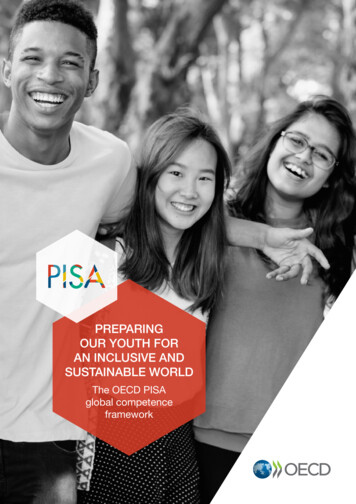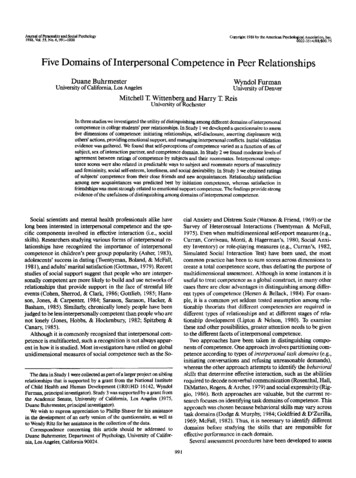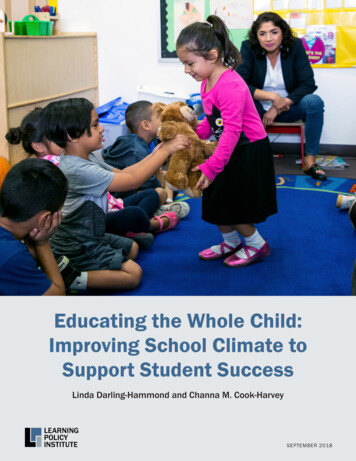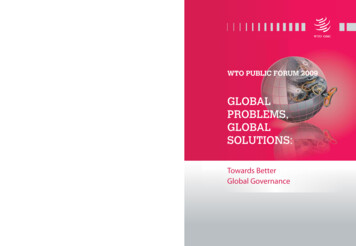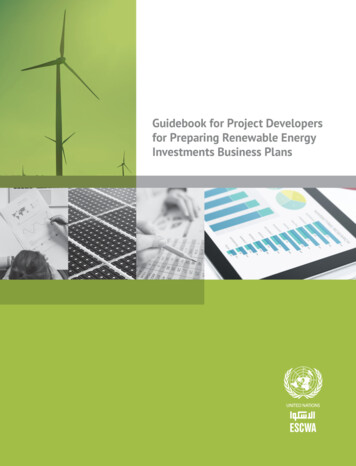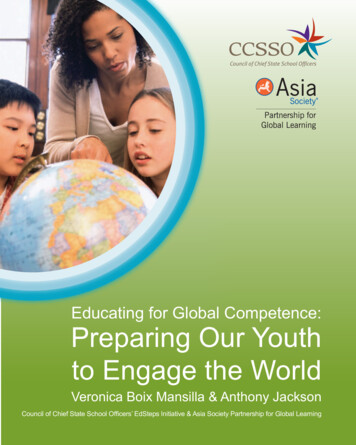
Transcription
Educating for Global Competence:Preparing Our Youthto Engage the WorldVeronica Boix Mansilla & Anthony JacksonCouncil of Chief State School Officers’ EdSteps Initiative & Asia Society Partnership for Global Learning
Asia Society is the leading global and pan-Asian organization workingto strengthen relationships and promote understanding amongthe people, leaders, and institutions of the United States and Asia.The Society seeks to increase knowledge and enhance dialogue,encourage creative expression, and generate new ideas across thefields of arts and culture, policy and business, and education. TheAsia Society Partnership for Global Learning develops youth to beglobally competent citizens, workers, and leaders by equipping themwith the knowledge and skills needed for success in an increasinglyinterconnected world.The Council of Chief State School Officers (CCSSO) is a nonpartisan,nationwide, nonprofit organization of public officials who headdepartments of elementary and secondary education in the states, theDistrict of Columbia, the Department of Defense Education Activity,and five U.S. extra-state jurisdictions. CCSSO provides leadership,advocacy, and technical assistance on major educational issues. TheCouncil seeks member consensus on major educational issues andexpresses their views to civic and professional organizations, federalagencies, Congress, and the public.Asia SocietyVishakha N. Desai, PresidentAsia Society725 Park AvenueNew York, NY 10021voice: 212-288-6400 · fax: 212-517-8315www.asiasociety.org/educationCouncil of Chief State School OfficersChristopher Koch, PresidentGene Wilhoit, Executive DirectorCouncil of Chief State School OfficersOne Massachusetts Avenue, NW · Suite 700Washington, DC 20001-1431voice: 202.336.7000 · fax: 202.408.8072www.ccsso.orgEditorEvan OmersoCopyright 2011 by the Asia SocietyAll rights reserved
Table of ContentsEdSteps Global Competence Task Force Members. ivA Note from the Authors. vForeword . viPreface. viiiIntroduction. xiChapter Ia raTIonale for global CompeTenCe. 1Chapter IIundersTandIng The world Through dIsCIplInaryand InTerdIsCIplInary sTudy. 11Chapter IIIglobally CompeTenT sTudenTs InvesTIgaTe The world. 21Chapter IVglobally CompeTenT sTudenTs reCognIze perspeCTIves. 31Chapter Vglobally CompeTenT sTudenTs CommunICaTe Ideas. 39Chapter VIglobally CompeTenT sTudenTs Take aCTIon. 45Chapter VIITeaChIng for global CompeTenCe. 53Chapter VIIIeduCaTIng for global CompeTenCe: whaT sChools Can do. 77Chapter IXpromoTIng global CompeTenCe Through publIC polICy. 89ConClusIon. 97appendICes. 101References.111BIOGRAPHIES.117Educating for Global Competence: Preparing Our Youth to Engage the Worldv
EdSteps Global Competence Task Force MembersShari AlbrightTrinity University, San Antonio, TXMichele Anciaux AokiWashington State Office ofSuperintendent of Public InstructionMargaret Reed MillarCouncil of Chief State School OfficersRobert AustinUtah State Office of EducationDavid MolinaConsultant, Asia SocietyVeronica Boix MansillaHarvard Graduate School of EducationDonna NesbittOhio Department of EducationKelly CallawayTexas Education AgencyMatt NinkGlobal Youth Leadership InstituteJennifer Chidsey PizzoRoss InstituteMartha Reichrath, Ph.D.Georgia Department of EducationThomas CorcoranTeachers College, Columbia UniversityGregg RobertsUtah State Office of EducationEllen EstradaWalter Payton College Prep,Chicago, ILPaul SandrockWisconsin Department of Public InstructionRegina ScotchieWest Virginia Department of EducationGerhard FischerWisconsin Department ofPublic InstructionKirsten TaylorCouncil of Chief State School OfficersBetsy Devlin-FoltzU.S. Department of StateElizabeth WebbGwinnett County Public Schools, GAAnthony JacksonAsia SocietyDr. Heidi Hayes JacobsPresident, Curriculum DesignersDirector of Curriculum 21www.curriculum21.comviJanis JensenKean University, School for GlobalEducation & InnovationGilda WheelerWashington State Office ofSuperintendent of Public InstructionEducating for Global Competence: Preparing Our Youth to Engage the World
A note from the authors:We would like to thank our colleagues on the EdSteps Global Competence Task Force, whoseextensive expertise and collaborative efforts enabled us to advance the definition of globalcompetence that sets the foundation for this book. We thank the teachers, students and leadersat the Asia Society’s International Studies Schools Network, the International Baccalaureate,and Harvard Project Zero for their inspiring cases of global education. A special thanks goesto Heather Singmaster at Asia Society for expertly managing the project, to Flossie Chuaat Harvard Project Zero for her editorial comments on earlier drafts, and to Margaret Millarand Kirsten Taylor at the Council of Chief State Schools Officers for their informed supportthroughout the book’s development.Educating for Global Competence: Preparing Our Youth to Engage the Worldvii
ForewordOver the past several years I have had the opportunity to travel with chief state school officersto different places around the world—places such as China, England, Finland, and Singapore—to learn more about their education systems. These visits have underscored for me how factorslike rapidly advancing technologies and global economic integration increasingly connect usall to communities throughout the world. Educators, whether in Louisville or Helsinki, face thesame challenge as they prepare our students to live and work in the 21st century. I have foundthat in all countries people recognize the direct relation between their economic future and theeffective education of their children. It is abundantly clear that the most advanced countries inthe world are strongly committed to the continuous improvement of their education system. Inthese nations people are willing to make sacrifices—on a personal level and societal level—todo what is necessary to improve their children’s future. After each visit, I have been left with agreater sense of urgency about the necessity to improve the education of our children by bettersupporting the development of their higher order thinking skills and their ability to apply theseskills effectively to a broad range of problems. It is, in part, these skills that will enable them toinvent and contribute to the new world.It is in this context that EdSteps was founded. With funding from the Bill and Melinda GatesFoundation, the Council of Chief State School Officers (CCSSO) began exploring how to defineand assess complex sets of important skills and competences that traditionally have beenexpensive and difficult to evaluate. After a comprehensive literature review, a survey of criticalskills in the field, and discussions with representatives from a broad range of education andbusiness organizations, it became clear that global competence needed to be included as oneof the competences in EdSteps. To explore this issue, CCSSO, in collaboration with the AsiaSociety Partnership for Global Learning, commissioned a task force on global competence. Thetask force comprises representatives from state education agencies, nonprofit organizationsfocused on global education, and representatives from higher education institutions who aretasked with exploring global competence.The task force met frequently for more than a year to discuss and refine the definition of globalcompetence. They evaluated research and best practices to explore what capacities a globallycompetent student should embody. This work prepared the way for the formulation of thedefinition of global competence and related capacities set forth in this book. By providing ashared understanding of global competence, the task force has made a significant contributionto this emerging field. I appreciate all the hard work of the task force members, and I amconfident that this definition will prove useful to educators throughout the world.In writing this book, Veronica Boix Mansilla and Anthony Jackson have drawn on andelaborated the insights of fellow members of the global competence task force, furtherdeveloping their thinking. The resulting work provides a useful context for the relevance ofglobal competence in education, as well as clear practical applications demonstrating whatglobal competence looks like in interactions between educators and learners. Educating forGlobal Competence: Preparing Our Youth to Engage the World will serve as an invaluableviiiEducating for Global Competence: Preparing Our Youth to Engage the World
resource for educators, administrators, policymakers, community leaders, parents, andstudents. While this book does not represent the official position of the chief state schoolofficers or CCSSO, it should serve as a catalyst and resource for ongoing conversations andplanning. It will help all of us think creatively and critically about how to better prepare thelearners of today for the world in which they live.I would like to thank Veronica and Tony for their efforts and the Asia Society Partnership forGlobal Learning for partnering in the important work of EdSteps and the co-publication ofthis valuable book.Through my visits to schools in countries around the world, I have personally witnessedstudents exhibiting the global competences fully explored in this book—investigating theworld, recognizing perspectives, communicating ideas, and taking action. The process oflearning from and collaborating with global educational leaders has been vital to informing thework of CCSSO and transforming the United States education system. It is clear there is stillmuch work to be done. The states are committed to implementing reforms that will prepare thenext generation of learners for lifelong learning, meaningful work, and citizenship in the world.It is my hope that this book will serve to elevate the national dialogue on these critical issuesand provide concrete examples and resources to foster global competence in our children. Ourfuture depends on our ability to work together to meet these daunting challenges.Gene WilhoitExecutive Director, Council of Chief State School OfficersEducating for Global Competence: Preparing Our Youth to Engage the Worldix
PrefaceFrom one admittedly privileged standpoint, this book should not be necessary. In the mindsof most who have thought about it, it is clear that today’s students need a globally consciouseducation for what is assuredly a global era. Young people need to understand the worldwidecirculation of ideas, products, fashions, media, ideologies, and human beings. Thesephenomena are real, powerful, ubiquitous. By the same token, those growing up in the worldof today—and tomorrow!—need preparation to tackle the range of pervasive problems:human conflict, climate change, poverty, the spread of disease, the control of nuclear energy.And yet this excellent, pioneering, aptly illustrated book is timelier and more necessary thanever. To be sure, one can locate scattered examples of exemplary teaching for our globalera. Yet the vast majority of teaching around the world is still geared to preparing youngpeople for lives in the 19 th and 20 th centuries. Our curricula (organized around traditionalsubjects), our forms of pedagogy (largely lectures), our use of media (largely text on slides),and our forms of assessment (often restricted to multiple-choice or short-answer responses)have changed remarkably little over the decades. Certainly these educational mainstays donot confront the issues I mention above.A lifetime of research and decades engaged in practice have convinced me that one isunlikely to bring about change unless one understands deeply the obstacles to change. Inthe case of global education, they are considerable. To mention just the most prominent:x With some exceptions, educators and policymakers concerned with education, howeverwell meaning, have not themselves had the opportunity to think much about educationfor a truly global era; and even if they have, their own education has rarely preparedthem to undertake such education seriously and effectively. Despite scattered calls for 21st-century skills and knowledge, there is no deep desire forsuch innovative education on the part of most families, or most citizens. We have nearlyall been to school, we think we know what it should be like, and school approachesappearing markedly different from the “known” rarely find a favorable response inthe community. At most, innovations are tolerated as long as they lead to adequateperformance on traditional measures. Even when there is both the desire and the policy for a 21st-century education, ourassessments are almost all geared for classical subject matter knowledge and almostnever offer the means to assess the flexible, cooperative thinking that is the hallmark ofinterdisciplinary thought. Perhaps most perniciously in the United States—but, alas, not only in the UnitedStates—there is a deep distrust of education that attempts to transcend borders and totake seriously the customs, values, and priorities of nations and regions very differentfrom one’s own—and such provincialism and exceptionalism grows more fervent intimes of crisis. Cosmopolitanism, internationalism, and globalism are often considereddangerous concepts or even “fighting words.”Educating for Global Competence: Preparing Our Youth to Engage the World
And yet, there are also hopeful signs. Young people often do not share the prejudices oftheir elders, and even when they do, their minds are far more likely to be changed. Youngerteachers are more comfortable with new ideas, new media, and new practices—aspectsof globalization are in their DNA. Specimen curricula, pedagogies, and assessmentsas described in this book are becoming better known and may well gain in popularity.Ultimately, those regions and nations that do transform their educational systems in theways called for here will soon come to the fore internationally. And those examples—bethey in India, Indonesia, Israel, or Italy—will prod the more dilatory nations to follow suit,lest they be left in the dust.Not surprisingly, as someone who has been deeply involved in education and educationalreform, I read this book in the light of my own ideas and priorities. Because of my longtime and highly valued association with Veronica Boix Mansilla, I find the ideas hereinvery congenial. There is recognition of the importance of different ways of knowing,individualized curricula, performances of understanding, interdisciplinary stances, and thepressing need for minds that can go beyond standard disciplinary mastery, synthesizingacross the spectrum of knowledge and creating broad-based new knowledge.If I could foreground one personal preoccupation, it would be this: Around the world,ministers of education monitor their nation’s place in international rankings. They cheerwhen it goes up, and they sweat when it goes down. In my view, it is important thatwe learn from what other countries are doing well. I admire countries like Finland andSingapore, which are in many respects so different from one another but nonethelesshave high-performing students. However, the world will not be saved by high testscores. Throughout the 20 th century and into the 21st we have seen all too well theincredible world-defying blunders committed by the so-called best and brightest. Thedisastrous Vietnam war, the unforeseen consequences of the invasion of Iraq, the financialmeltdowns of 2001 and 2008—educational and financial elites bear much of the blame forthese lamentable events.What is needed more than ever is a laser-like focus on the kinds of human beings that weare raising and the kinds of societies—indeed, in a global era, the kind of world society—that we are fashioning. That is why for almost two decades, my colleagues and I havebeen studying what makes good persons, good workers, and good citizens, and why inrecent years we have sought to go beyond study and nurture these positive qualities inyoung people. Most young people want to “do good”—they want to do the right thing.But the models they see about them often carry out work that is ridden with compromisesand practice citizenship in irresponsible ways. As educators, we must model thesepositive virtues ourselves; we must explain the reasons why we do what we do and whywe do not endorse other, perhaps tempting, alternatives; we must be willing to confrontexamples of bad work and bad citizenship, whether they occur among 20-year-olds or60-year-olds, in history, literature, and our hometown; and we must help young peopledevelop their own ethical compasses, which they can and should use in conjunction withtheir mentors and their peers.Educating for Global Competence: Preparing Our Youth to Engage the Worldxi
To achieve such ambitious ends, a global education is certainly necessary. And if we are tohave a globe worth inhabiting, we must attend unflinchingly to the kinds of human beingsthat will inhabit it, and the ways in which they deal with one another under often tryingcircumstances. The authors here call for action: I agree, but would add the phrase “wellmotivated, constructive, world-building actions.”Howard Gardner, author of Truth, Beauty, and Goodness ReframedCambridge, MAxiiEducating for Global Competence: Preparing Our Youth to Engage the World
IntroductionContemporary societies are marked by new global trends—economic, cultural,technological, and environmental shifts that are part of a rapid and uneven wave ofglobalization. The growing global interdependence that characterizes our time calls fora generation of individuals who can engage in effective global problem solving andparticipate simultaneously in local, national, and global civic life. Put simply, preparing ourstudents to participate fully in today’s and tomorrow’s world demands that we nurture theirglobal competence.This document introduces a definition of global competence developed by the GlobalCompetence Task Force—a group of state education agency leaders, education scholars,and practitioners—under the auspices of the Council of Chief State School Officers EdStepsinitiative (CCSSO-EdSteps) and the Asia Society Partnership for Global Learning (seepage (iv) for task force participants). The definition builds on seminal work within the statesand a broad range of organizations working to advance global knowledge and criticalthinking skills. A process of careful articulation and vetting yielded the definition of globalcompetence here proposed:Global competence is the capacity and disposition to understand and act onissues of global significance.Globally competent individuals are aware, curious, and interested in learning about the worldand how it works. They can use the big ideas, tools, methods, and languages that are centralto any discipline (mathematics, literature, history, science, and the arts) to engage the pressingissues of our time. They deploy and develop this expertise as they investigate such issues,recognizing multiple perspectives, communicating their views effectively, and taking action toimprove conditions.Educating for Global Competence: Preparing Our Youth to Engage the World is intendedfor classroom teachers, administrators, informal educators, policymakers, communityleaders, researchers, parents, students, and all other stakeholders interested in preparingour youth for the 21st century. Becoming better at educating for global competence involvesrethinking practices and recognizing that there are no simple recipes for success. As such,this book is meant to be used flexibly—browse, make connections, and concentrate onthe chapters that you find most pertinent to your work. Experiment with ideas, challengeconcepts, and share with colleagues. Ultimately this book must work for you. It is meant tobe read in the way that best meets your needs, inspires your curiosity, and proves fruitful inthe classroom.Chapter one offers a rationale for global education in our nation and worldwide. Chaptertwo introduces a conceptual framework for global competence and explains the key roleof disciplinary and interdisciplinary foundations in student learning. Chapters three, four,five, and six focus, respectively, on four core capacities associated with global competence:investigating the world, recognizing perspectives, communicating ideas, and taking action.Educating for Global Competence: Preparing Our Youth to Engage the Worldxiii
Chapter seven considers core principles of instruction for teaching global competence.Chapter eight looks at what schools and educational institutions can do to promote globalcompetence—and how they might create a culture of global competence for youth andadults. Finally, chapter nine places global competence in the larger framework of publiceducation systems in and beyond the United States.xivEducating for Global Competence: Preparing Our Youth to Engage the World
Chapter IA rationale for global competenceTwentieth-century assumptions about the world are rapidly becoming obsolete. Globalization,the digital revolution, mass migration, and the prospect of climate instability are triggeringnew concerns and demanding a new kind of graduate. At the dawn of the 21st century weare recasting our understanding of economics, communication, security, cultural identity,citizenship, and the environment. Indeed, a growing number of reports document the newdemands and opportunities these changes present our youth. They call for more powerful,relevant, and self-directed learning that will prepare the young to live, compete, andcollaborate in a new global scenario.1This chapter reviews three forces shaping lives on the planet: the flattened global economyand changing demands of work; unprecedented global migration and the changing nature ofneighborhoods, identities, and citizenship; and climate instability and the growing need forglobal environmental stewardship. These three areas of transformation illustrate a world intransition—and illuminate the new educational demands that world presents. The followingsections examine these selected transformations and explain how the proposed definition ofglobal competence helps educators respond to the challenges they present.The flattened global economy and changing demands of workConsider the changing face of the business world. A company in one country employs workersin another one. Consumers in a third country buy the goods produced. Transactions areaided by high-speed internet communication, the lowering of import tariffs, and governmentincentives for foreign investment. The result of these ordinary interconnections is a processof globalization—one of unprecedented reach and breathtaking speed and consequence.Globalization, the accelerating traffic of goods, ideas, people, and capital around the world,has leveled the playing field for workers all over.2 And increasingly, employers are looking forcompetent, reliable individuals who will work at an attractive cost—regardless of location.A new distribution of labor is in the making. Jobs that involve routinized tasks or scriptedresponses are being done by computers or workers in the developing world—with little trainingand at a very low cost. Yet jobs that demand expert thinking and complex communication willremain in growing demand the world over. At the beginning of the 20th century only 5 percent ofthe jobs in America required specialized knowledge and skill. By the year 2009 at least 70 percentdid so. Commentators such as Daniel Pink have pointed to the emergence of a “conceptual age”Educating for Global Competence: Preparing Our Youth to Engage the World1
that requires more than specialized skills and basic information. Our age demands workers able tosynthesize different types of information creatively.3 In fact, the top 10 in-demand jobs projectedfor 2010 did not exist six years ago. Here, too, international competition will prevail.4In the United States, the New Commission on the Skills of the American Workforce articulates thechallenge of global labor competition in sticking terms: “Today, Indian engineers make 7,500a year against 45,000 for an American engineer with the same qualifications. Even if we werematched with Indian engineers in high levels of mastery of mathematics and science, why wouldthe world’s employers pay us more than they have to pay Indian engineers to do their work?” Thecommission postulates that the key to successful participation in the new global labor market is a“deep vein of creativity that is constantly renewing itself.” It calls for a new generation of workerswho “imagine how people can use things that have been never available before, create ingeniousmarketing and sales campaigns, build furniture, write books, make movies, and imagine new kindsof software that will capture people’s imagination and become indispensable to millions.” In theirview, a high level of preparation in reading, writing, mathematics, science, literature, history, andthe arts will be essential.5What competences will students need to fare well in a flattenedglobal economy?Multiple skill sets have been put forth as essential to prepare our future workforce.6 They rangefrom learning, thinking, and innovation skills, such as thinking creatively and using systemsthinking, to skills associated with life and careers, such as designing, evaluating, and managingone’s own work for ongoing improvement and adapting to change. Collectively they offer adynamic portrait of learning. Surprisingly absent in public discourse about work readinessis the lack of deep understanding by students of issues of global significance—how globalmarkets operate, the promise and perils of transnational production, how social entrepreneurscontribute to human development while also meeting their bottom line, demands of economicand cultural development, and the dilemmas of inequality—to name a few.The definition of global competence developed by the CCSSO/Asia Society task forcecomplements the work readiness skills proposed by focusing educators’ attention on students’deep understanding of and effective participation in the world in which we live. Thesecapacities are not generic work, digital, social, or information processing skills. Rather, in thisframework, competence is recast in global terms. It refers to students’ dynamic learning about,with, in, and for a complex andinterconnected world. To be competitive,[In my opinion] both teachers and students internalizethe value behind a globally-focused learning adventure. Itethical, and effective workers, today’sallows teachers to be passionate about their own practice,students must understand key topics ofit equips students with the skills necessary to confront themany challenges of our ever flattening world.global significance in areas likeSusanna Pierceengineering, business, science, history,Teacherecology, and other domains that mayInternational School of the AmericasSan Antonio, Texasconstitute their future work. They mustlearn to think and work like an expert,2Educating for Global Competence: Preparing Our Youth to Engage the World
whatever the area of the curriculum or personal interest. They must understand the veryeconomic, technological, and social forces shaping their lives and their future work.Globally competent students prepare for a global economy by learning how to investigatematters of global significance. Are social networking technologies developing in the same ways incountries like the U.S. and China? What are the economic, social, and environmental consequencesof outsourcing to India and Mexico? What tools do governments have to promote economicdevelopment and eradicate extreme poverty? Engaging complex and pertinent questions of thiskind can encourage students to recognize their own and others’ perspectives and communicatetheir positions clearly—two additional capacities that are especially important to today’s globalwork teams. Most importantly, preparing to work in a flattened global economy will require thatstudents learn to take action. It requires that they learn to identify opportunities for productiveaction and develop and carry out informed plans. For example, students may learn to designand promote products to succeed in a digital world or develop an awareness campaign on theenvironmental consequences of their city’s purchasing habits. Prepared students, this frameworksuggests, view themselves as informed, thoughtful, and effective workers in changing times.Unprecedented global migrationInternational migration is happening on a larger scale than ever, changing the demographicsof classrooms and neighborhoods alike. According to data from the United NationsPopulation Division, by the summer of2010 the total number of migrants in theTeaching for global competence is essential to lifelonglearners. Too often educators minimize the wealth ofworld will have been about 214 million.knowled
to this emerging field. I appreciate all the hard work of the task force members, and I am confident that this definition will prove useful to educators throughout the world. In writing this book, Veronica Boix Mansilla and Anthony Jackson have drawn on and elaborated the insights of fellow members of the global competence task force, further






